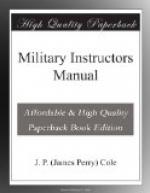follow each parry.
5. The foot movements shown in the old manual are useful only to
promote quickness and steadiness. They should, therefore, be
practiced in combination with the points and butt blows, and so
combined can be executed in the oblique directions as well as at
right angles. The left foot moves in the direction of the
thrust.
D. MANUAL OF THE BAYONET: There are only 7 exercises
to learn in the
new bayonet drill:
1. Guard.—Point
of the bayonet directed at the opponent’s
throat, the rifle
held easily and naturally with both hands,
barrel inclined
slightly to the left, right hand at the height
of the navel and
grasping the small of the stock, left hand
holding the rifle
at a convenient position above the lower
band, so that
the left arm is slightly bent, making an angle of
about 150 degrees.
The legs should be well separated and in an
easy position.
Lean forward, on your toes, left knee slightly
bent, right foot
flat on the ground and turned to the right
front. Remember
in this position to have your eye on your
opponent, do not
restrain your muscles, keep them taut, but
flexible.
2. “High Port.”—The
hands hold the rifle as in guard; the left
wrist level with,
and directly in front of the left shoulder;
the right hand
above the right groin and on level with the
navel.
Remember that
the barrel in this position is to the rear. This
position is assumed
on the advance without command.
3. “Long Point.”—Being
in the position of “guard,” grasp the
rifle firmly,
vigorously deliver the point to the full extent
of the left arm,
butt along side and close to the right
forearm; body
inclined forward; left knee well bent, right leg
braced, and weight
of the body pressed well forward with the
fore part of the
right foot, heel raised. The right hand gives
the power to the
point, while the left guides it. If a point is
made in the oblique
direction the left foot should move in that
direction.
This exercise is done in 3 counts. At 1 the point
is
made; at 2, the
withdrawal; at 3, resume the guard. The
withdrawal must
be straight back, and not with the downward
motion, until
the right hand is well behind the hip.
4. Right (Left) Parry.—1.
Straighten the left arm, without
bending the wrist
or twisting the rifle in the hand, and force
the rifle forward
far enough to the right (left) to ward off
the opponent’s
weapon, 2. Resume “guard.”
Remember to keep
your eyes on the weapon to be parried.
5. Short Point.—1.
Shift the left hand quickly toward the




